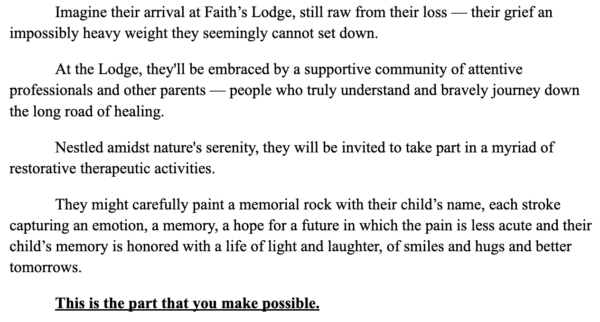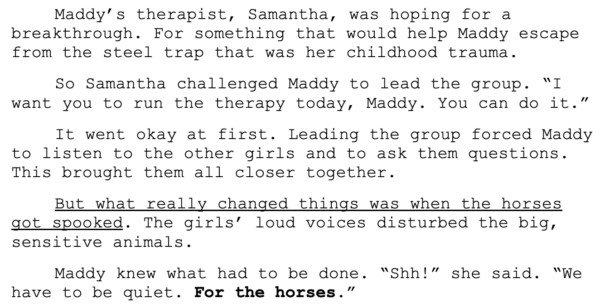The following is a hand-picked guest post from Julie Cooper. Enjoy, and you can read more about Julie below.
* * *
Want donors to feel your mission? Stop writing articles. Start setting scenes instead.
Tom Ahern once said to me, “Most copywriters are frustrated novelists.”
I was intrigued.
Tom went on to explain that at a conference some years ago, he met up with several other world-class fundraising copywriters at a bar, and they compared notes and stories over drinks.
That’s when they found they had one thing in common: they’d all written novels. (I guess the “frustrated” part of “frustrated novelist” came from not hitting Stephen King- or J.K. Rowling-level jackpot literary success.)
Huh. Interesting.
Brett has written novels…
And I’ve helped revise and edit them…
It struck me: this common denominator is not a mere coincidence. It’s essential to fundraising writing success.
You have to know how to put your donors right in the middle of a scene. That way, they’ll really FEEL the urgency, really SEE the need, really WANT to help.
Turns out, you don’t actually have to write a novel. You just have to understand what novelists know in their bones…
People are storytelling creatures.
Our lives are stories. We can never get enough.
This is why:
- Stories bind us over the dinner table.
- Stories connect us over social media.
- Stories glue us to our screens (and books and…).
- Stories help us “live a thousand lifetimes.”
- Stories guide us away from bad futures and toward good ones.
- Stories change the world.
A good story is immersive. You feel like you’re there.
So how can you put your donors “on the scene,” where the need is, where they can help?
First, set the scene.
Put your donors in a place and time.
Like this:

Second, add sensory details.
Put your donors in a “body” that experiences the world.
Like this:

Third, add interior thoughts.
Put your donors in a mental space.
Like this:

Fourth, add emotions.
Put your donors in an emotional place.
Like this:

Fifth, add dialogue.
Put your donors in the middle of an exchange.
Like this:

If you do all this – if you write vivid scenes worthy of a novel, not dry articles worthy of The Wall Street Journal – you’ll put your donors in the middle of your story.
Your story will become your donors’ story.
Your donors will have a visceral connection to your mission.
They’ll get it.
They’ll feel what you feel.
They’ll want what you want.
They’ll be with you for the long haul.
Now that’s a happy ending.
* * *
Steven says, “This guest post is from Julie Cooper, the ‘fundraising copywriter and donor communications specialist’ who I’m THRILLED to share with you. Julie’s (and her partner Brett’s ) newsletter and blog are full of fun, practical advice.”



